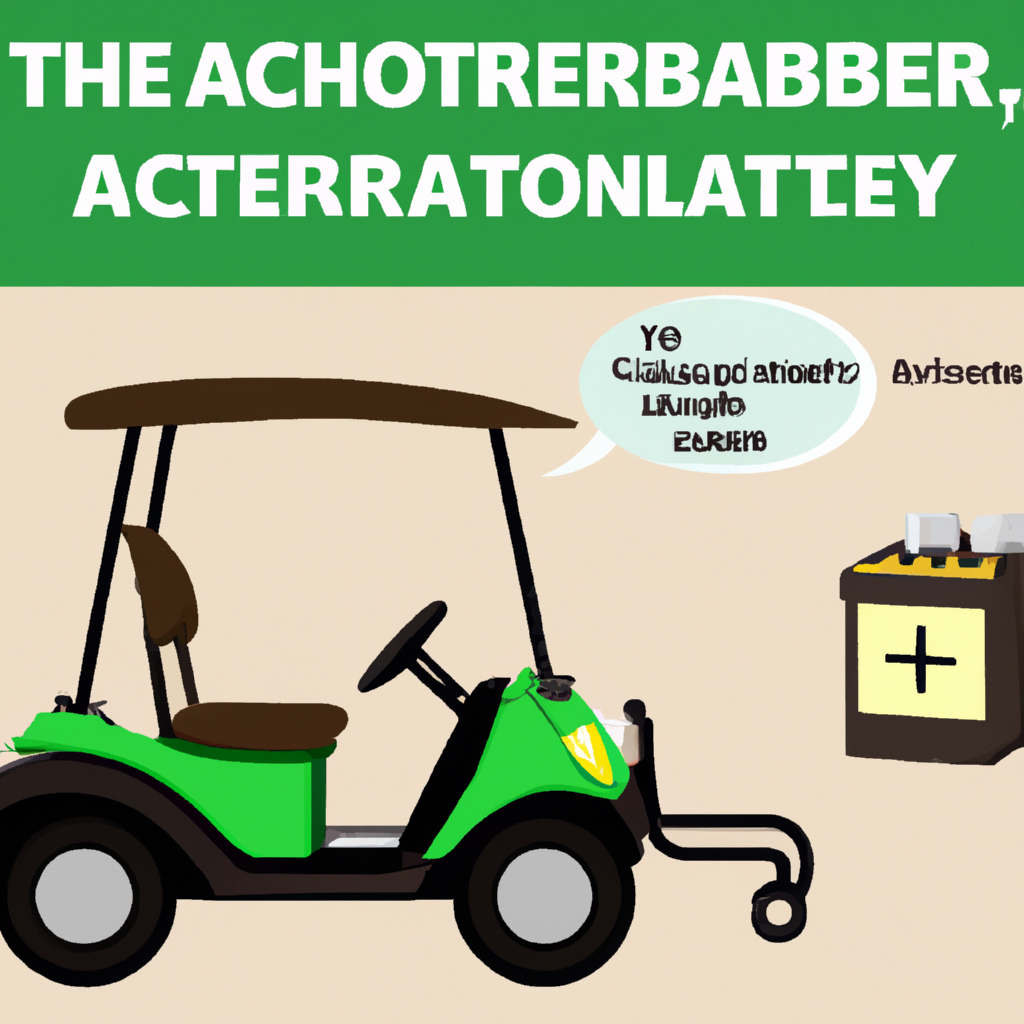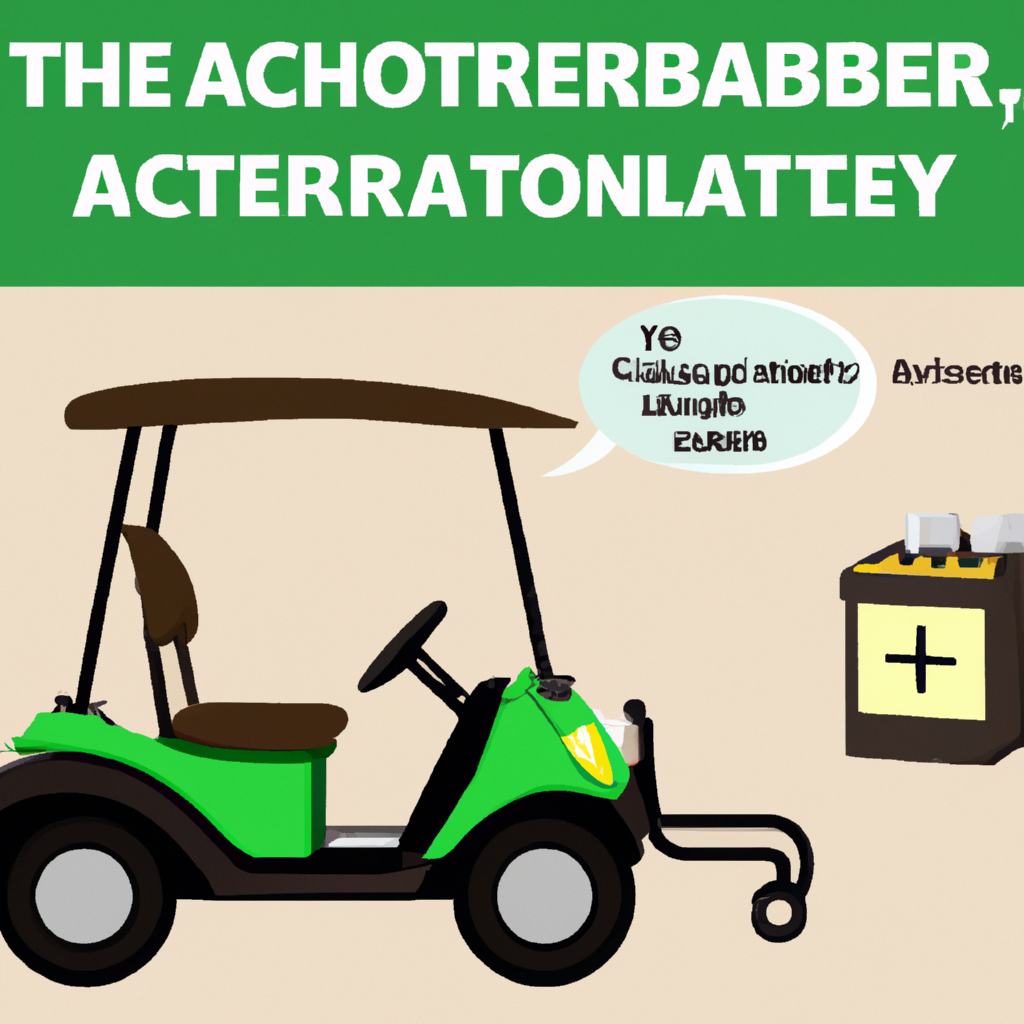We may earn money or products from the companies that may be mentioned in this post.
Do you find yourself facing the frustrating issue of your golf cart battery not charging? Don’t worry, you’re not alone. In this article, we will explore some common reasons why your golf cart battery may be refusing to charge and provide solutions to help you get back on the green in no time. So, let’s troubleshoot the problem together and get your golf cart battery back to its full potential!
Common Issues: Golf Cart Battery Won’t Charge
If you’re facing the frustrating issue of your golf cart battery not charging, there are several factors that could be responsible for this problem. In this article, we will explore the most common issues that can prevent your golf cart battery from charging and provide you with solutions to help get your battery back up and running.

1. Battery is Dead
1.1 Battery Age
One possible reason why your golf cart battery is not charging is that it may have reached the end of its lifespan. Over time, batteries naturally deteriorate and lose their ability to hold a charge. If your battery is old and has been used for many years, it may be time to replace it with a new one.
1.2 Battery Has Reached Its Lifespan
Another factor to consider is the lifespan of the battery. Golf cart batteries typically have a lifespan of about 4-6 years, depending on usage and maintenance. If your battery is nearing the end of its lifespan, it may no longer be able to hold a charge effectively, leading to charging issues.
1.3 Battery is Completely Drained
If your golf cart battery is completely drained, it may not accept a charge. This can occur if the battery has been left unused for a long period or if you have accidentally left the lights or other accessories running, draining the battery. In such cases, you may need to jump-start the battery or use an external charger to revive it before attempting to charge it using the golf cart’s charger.
2. Poor Connection
2.1 Loose, Corroded, or Dirty Battery Terminals
A common cause of charging problems in golf cart batteries is poor connection at the battery terminals. Over time, battery terminals can become loose, corroded, or covered in dirt and grime, resulting in a weak or broken connection. Make sure to check the battery terminals and clean them if necessary. Tighten any loose connections to ensure a solid electrical connection for proper charging.
2.2 Faulty Wiring
Faulty wiring can also prevent your golf cart battery from charging. Inspect the wiring connections between the battery, charger, and any other electrical components for any signs of damage or loose connections. If you notice any issues, replace or repair the faulty wiring to restore proper charging functionality.
2.3 Loose or Damaged Charging Port
The charging port on your golf cart can also become loose or damaged over time, leading to charging problems. Ensure that the charging port is securely connected to the battery and that there is no physical damage. If the charging port is loose or damaged, it may need to be repaired or replaced to enable successful charging.
3. Over or Undercharged Battery
3.1 Improper Charging Procedure
Improper charging procedures can have a significant impact on the performance and lifespan of your golf cart battery. It is essential to follow the recommended charging guidelines provided by the battery manufacturer. Overcharging or undercharging the battery can lead to charging issues and reduce the battery’s overall capacity. Make sure to monitor the charging process and avoid leaving the battery connected to the charger for extended periods.
3.2 Malfunctioning Charger
A faulty or malfunctioning charger can hamper the charging process. If you suspect that the charger is not functioning correctly, try using a different charger or have it inspected by a professional. A certified technician can determine whether the charger needs repair or replacement to ensure proper charging of your golf cart battery.

4. Battery Water Levels
4.1 Inadequate Water Levels
Golf cart batteries are often flooded lead-acid batteries that require regular maintenance, including monitoring the water levels. Low water levels in the battery can hinder proper charging and lead to decreased battery performance. Check the water levels regularly and add distilled water if necessary, ensuring that the plates inside the battery are adequately submerged.
4.2 Overfilled Battery Cells
On the other hand, overfilling the battery cells with water can also cause charging issues. Excessive water levels can result in electrolyte overflow during the charging process, affecting the battery’s performance and charging capacity. Maintain the water levels within the recommended range provided by the battery manufacturer to prevent overfilling.
5. Faulty Charger
5.1 Charger Cables or Plugs are Damaged
Damaged charger cables or plugs can prevent your golf cart battery from charging properly. Inspect the charger cables for any signs of wear, fraying, or damage. Similarly, check the plugs for bent pins or loose connections. If you notice any issues, replace the damaged cables or plugs to ensure a secure and reliable charging connection.
5.2 Charger is not Compatible
Using an incompatible charger can also lead to charging problems. Make sure that the charger you are using is specifically designed for your golf cart battery type and voltage. Using the wrong charger can result in undercharging or overcharging, damaging the battery and affecting its overall performance.
5.3 Charging Mode or Timer Issues
Some chargers allow you to select different charging modes or have built-in timers. If these settings are misconfigured, it can affect the charging process. Review the charger’s user manual and verify that the charging mode and timer settings are correctly adjusted for your battery type and requirements.
6. Battery Sulfation
6.1 Sulfation Build-Up
Sulfation is a common issue in lead-acid batteries and occurs when sulfate crystals accumulate on the battery plates over time. This build-up can impede the charging process and reduce the battery’s capacity. Proper battery maintenance, including regular equalization charges, can help prevent or reduce sulfation build-up.
6.2 Sulfation Due to Deep Discharge
Deep discharging your golf cart battery can contribute to sulfation. Avoid discharging the battery to excessively low levels and recharge it promptly after use. This practice helps prevent sulfation and prolongs the battery’s lifespan.
6.3 Sulfation Caused by Undercharging
Undercharging the battery, particularly when it is used infrequently, can also lead to sulfation. Make sure to adhere to the recommended charging procedures and avoid leaving the battery undercharged for extended periods. Regularly charge the battery to maintain optimal performance and prevent sulfation.
7. Battery Load Test
7.1 Battery Capacity Test
Performing a battery load test can help determine the overall health and capacity of your golf cart battery. This test involves applying a load to the battery while measuring its voltage and observing how it performs. A professional technician can conduct this test and provide you with insights into your battery’s condition.
7.2 Battery Voltage Test
Measuring the battery’s voltage is another way to assess its overall capacity and health. A fully charged 12-volt battery should read around 12.7-12.8 volts. If you notice significantly lower voltage readings, it may indicate a problem with the battery or charging system that requires further investigation.
8. Faulty Voltage Regulator
8.1 Voltage Regulator Failure
The voltage regulator controls the charging voltage provided to the battery. If the voltage regulator fails, it can lead to overcharging or undercharging of the battery, preventing it from charging properly. Professional assistance may be required to diagnose and replace a faulty voltage regulator.
8.2 Voltage Regulator Overcharging
In some cases, a faulty voltage regulator may cause overcharging of the battery. Overcharging can damage the battery and decrease its overall lifespan. If you suspect that your golf cart battery is overcharging, seek professional help to assess and rectify the voltage regulator issue.
9. Thermal Sensor Malfunction
9.1 Thermal Sensor Failure
Golf cart batteries often have thermal sensors that monitor and adjust the charging process to prevent overheating. If the thermal sensor fails, it can impact the charging process, leading to incorrect charging levels or interrupted charging cycles. Consult a professional to diagnose and replace a faulty thermal sensor.
9.2 Thermal Sensor Sensitivity Issues
Thermal sensors can also experience sensitivity issues, causing them to trigger prematurely or not respond to temperature changes correctly. This can disrupt the charging process and affect the battery’s overall performance. Have a trained technician check and recalibrate the thermal sensor for proper functionality.
10. Internal Battery Damage
10.1 Physical Damage
Physical damage to the battery, such as cracks or leaks, can prevent it from charging correctly. Inspect the battery for any visible signs of damage and replace it if necessary. Additionally, excessive vibration or impact while driving the golf cart can also cause internal damage to the battery, affecting its charging capabilities.
10.2 Internal Short Circuit
An internal short circuit within the battery can also hinder the charging process. Short circuits can occur due to damaged or worn-out internal components, resulting in a loss of charge and decreased battery performance. If you suspect an internal short circuit, it is best to consult a professional for assessment and potential battery replacement.
In conclusion, there are several common issues that can prevent your golf cart battery from charging. By understanding these factors and implementing the appropriate solutions, you can address the problem and ensure that your battery regains its charging capabilities. Remember to regularly maintain your battery, follow proper charging procedures, and seek professional help when needed to optimize the lifespan and performance of your golf cart battery.
